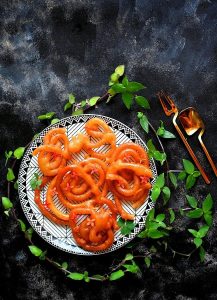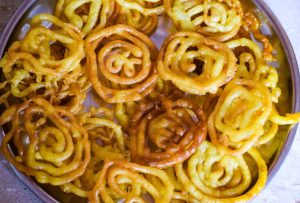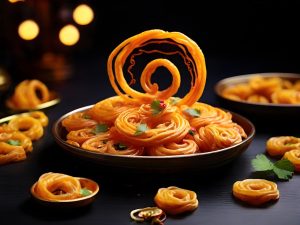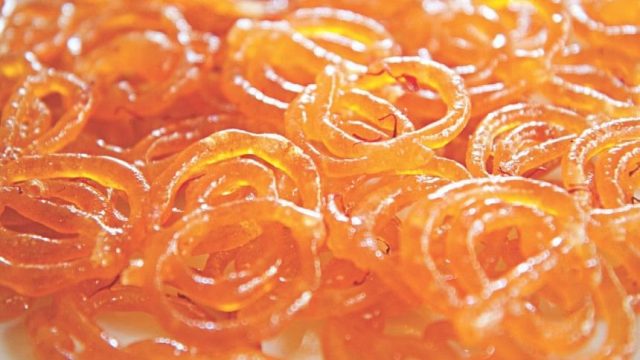For Bangladesh’s Muslims, Ramadan is a sensory feast. A symphony of anarchy and delight is created by the melodic call to prayer, the sizzling of piyaju fried in hot oil, and the fervent screams of street vendors yelling, “Bhai, gorom jilapi!” Among this energetic scene, one treat jumps out as the unquestionable star of iftar: the golden, syrup-drenched jilapi. Jilapi holds a particular place in the hearts of Bangladeshis during Ramadan whether eaten on its own or with muri makhano, a puff rice salad.
But what appeals so much about this sweet, crispy treat? Let’s investigate why jilapi rules supreme on every iftar table and enter the realm of this cuisine.

A Slothful of History: Jilapi’s Beginning
Rich in history, Jilapi, sometimes called jalebi, originated in the Mughal age. Persian traders brought this deep-fried treat to the Indian subcontinent, and soon residents started loving it. Its complex swirls and syrupy syrup came to represent festivity and luxury. Jilapi became a Ramadan staple over time, with each location giving the recipe its spin.
In Bangladesh, jilapi is a cultural emblem rather than only a treat. During Ramadan jilapi is everywhere, from the busy streets of Old Dhaka to the elegant iftar spreads in luxury hotels. Its adaptability is unparalleled; some like it thick and syrupy and others thin and crunchy. Then there are the imaginative variants, like rabri jilapi or saffron-infused jilapi, which elevate this modest pleasure to gourmet proportions.

The Great Debate: Jilapi in Muri Makhano
Though jilapi is delicious on its own, its combination with muri makhano has generated a strong argument. Muri makhano is a basic yet delicious combination of puffed rice, mustard oil, onions, green chilies, and a bit of salt for the uninitiated. For some, though, this simple meal lacks complements without a bit of jilapi crumbled in it.
The Couples:
University student Shahin is a fervent supporter of the jilapi-miri combo. “Sweet and savory is the ultimate pairing,” he contends. “The crisp muri, mustard oil’s sharpness, and jilapi’s sweetness strike the ideal mix. It just works, like salty caramel or cheese with honey!” .
Agreeing is Mukta, a working homemaker. “Iftar prep is already really busy. Why should one use different plates for jilapi and muri? Just toss them together and appreciate the anarchy!
The objectives:
The Haters On the other side of the argument is Shefali, a working professional who likes things conventional. “Muri makhano should be light and revitalising. Including jilapi converts it into a sugar tsunami. It simply makes no sense, like combining biryani with Sherbet!”
Grandfather and self-described conventionalist Kashem Dadu also shares similar view. “Muri makhano was easy and perfect in my day. Their experiments are destroying it this new generation. What is next? In Jhalmui, chocolate syrup?
Jilapi: Representing Togetherness and Joy
Apart from the arguments, jilapi has more importance throughout Ramadan. It’s a symbol of happiness, memories, and camaraderie as much as a treat. Many have great nostalgia for childhood Ramadan’s when they see jilapi shimmering on the iftar table.
 From Mohammadpur, a banker, Tanveer remembers, “My grandfather would bring fresh jilapi from a tiny business in our neighborhood. Without it, Iftar felt not whole. The aroma of jilapi fried makes me go back to those times even now.
From Mohammadpur, a banker, Tanveer remembers, “My grandfather would bring fresh jilapi from a tiny business in our neighborhood. Without it, Iftar felt not whole. The aroma of jilapi fried makes me go back to those times even now.
For others, such as businessman Shuvroto Kanchan, jilapi serves as inspiration rather than merely a treat. “After my Ramadan gym sessions, I reward myself to rabri jilapi. My sweet payoff for keeping active is sweets!
Why Jilapi is Non-negotiable
Among often shifting food trends, jilapi is a constant in this globe. Jilapi still enthralls taste receptors whether it’s the traditional form from a street vendor or a gourmet spin from a high-end restaurant. Its golden swirls and sugary taste remind me of the straightforward pleasures of Ramadan.
One thing is apparent, though: jilapi is the indisputable king of iftar delights whether you choose to keep them separate or are team jilapi-in-muri. It’s a custom, a memory, a symbol of the love and friendliness that define Ramadan in Bangladesh, not only a dessert.


As you assemble around the iftar table with loved ones this Ramadan, stop to consider the enchantment of jilapi. Whether your taste is for crunchy, syrupy, or blended with muri, let it serve as a reminder of the delight of life and the pleasure of giving. Ramadan is, after all, about love, community, and lifelong memories creation, not only food.

























